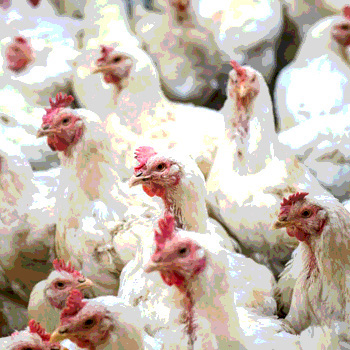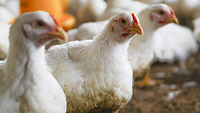Is Avian Influenza a Food Defense Issue?

The announcement of an avian influenza outbreak in commercial poultry is not good news for the industry, which is based in the southern tier of the United States. The United States Department of Agriculture (USDA)’s Animal and Plant Health Inspection Service (APHIS) confirmed earlier this year, the presence of highly pathogenic H7[1] avian influenza (HPAI) in a commercial chicken breeder flock in Lincoln County, Tennessee, close to the Alabama state border. Additionally, USDA-APHIS identified the isolate as having originated from wild birds. This is the first confirmed case of HPAI in commercial poultry in the United States this year. The flock of 73,500 is located within the Mississippi flyway, which likely means the virus is also present in the wild duck and goose populations, making the spread of the virus likely.
The scale of the poultry industry in the southern U.S. is hard for those outside the industry to imagine. Total broiler production for the U.S. was almost 8.6 billion birds in 2015. The top three broiler production states in the southern U.S. are Georgia, Alabama and Arkansas, which collectively accounted for more than 3.3 billion broilers of the total.[2] In addition to the actual number of broilers produced, the total live weight (weight of the bird before slaughter) produced in those same three states alone was in excess of 19 billion pounds.
By any measure, that is a lot of meat meant for the human food chain. If lost, that meat would be hard to replace, given that several other poultry-producing nations are struggling with avian influenza issues of their own, making alternative sources of the protein less likely and, even when available, far more expensive.
Could the Avian Influenza Virus Be Used to Intentionally Attack the U.S. Food Supply?
The simple answer to that question is yes; avian influenza virus could be diverted from an infected flock and used to attack the poultry industry in other parts of the region or the U.S. A more complete answer requires far more nuance. “Agroterrorism” is the term used to describe an intentional attack on the food production system, including animals or plants. Practically speaking, and for reasons that will not be discussed here because of security concerns, the likelihood of an intentional diversion of an infected bird or infective material, although not impossible, is highly unlikely. The earlier avian influenza outbreak is the result of unintentional contamination of a commercial flock, from a virus that was naturally present in waterfowl in the same area as the outbreak. There are no indicators that this outbreak is anything beyond a natural event of disease transmission.
Bioweapons Programs: Past and Present
In the past, several nations, including the U.S., had extensive military bioweapons programs that included, among other pathogens, those that could be used to target agriculture. In 1969, President Richard Nixon ordered the end of offensive bioweapons research in this country. The U.S. subsequently ratified two treaties: the 1925 Geneva Protocol and the 1972 Biological Weapons Convention, which collectively outlawed biological warfare. At the same time, the then-Soviet Union had a massive bioweapons program, dating back decades and involving many animal pathogens, including avian influenza.
Current indicators found in the open scientific literature provide some evidence of a revived interest in potential biological weapons programs by several adversarial nations. Whether these adversarial nations are actually conducting bioweapons research that includes pathogens like avian influenza is beyond the scope of this article. Suffice it to say, the creation of a major agroterrorism event on a scale that would actually endanger the U.S. food supply is beyond the capability of any single individual or even a group such as ISIS.
Such capability is confined to nation states, which have both sophisticated bioweapons and delivery capabilities. Such an intentional agroterrorism event would be considered by international law as being an act of war and therefore subject to economic and likely military retaliation by the United States.
Is There Potential for Employees to Intentionally Spread Avian Influenza?
Again, here the simple answer is yes, with a big caveat. Poultry companies are concerned about a number of diseases, including avian influenza, and have as a result instituted a series of standards and protocols related to biosecurity. A disgruntled employee or, for that matter, a poor-quality employee might choose to intentionally ignore biosecurity standards. Doing so could cause disease to gain a foothold or be spread within a complex.
Poultry companies have prepared for the scenario of an employee who does not vigorously uphold biosecurity standards by compartmentalizing operations wherever possible, thereby limiting access of employees to those areas and farms specifically under their charge. One can no longer enter a commercial poultry farm without permission or being noticed.
Poultry companies also have instituted rigorous surveillance programs, monitoring the health of the birds and quickly working toward containment should any disease event be discovered. In the current outbreak, avian influenza was identified very rapidly,[3] the birds were quarantined, and a depopulation plan was implemented immediately.[4] This is a quarantine system working well.
What Is the Future Likely to Bring?
Only time will tell whether USDA-APHIS has successfully gotten in front of this avian influenza event or whether additional cases will occur. Since HPAI is likely present in the wild waterfowl population in the Mississippi flyway, chances are this might not be the last case. The company that owns the affected flock, as well as those facilities adjacent to the affected farm owned by other poultry companies, likely will ramp up biosecurity programs, becoming even more aggressive about limiting access of employees and non-employees. None of the meat from the affected flock entered the food supply, nor will it ever. The U.S. consumer is not at risk because of this outbreak. The flock was euthanized according to USDA-APHIS approved protocols, and the carcasses will be buried in a way in which they cannot contaminate other poultry, groundwater or the food supply.
The potential threat to human health is also minimal. Although avian influenza deaths in humans have occurred in Asia and elsewhere, no human deaths have been attributed to outbreaks of avian influenza in North America. Avian influenza virus is capable of genetic changes that can cause it to become pathogenic to humans, but to date, the disease in North America remains confined to poultry and waterfowl and is currently not a public health problem.
Food Defense—Next Steps?
Even though avian influenza is more of a biosecurity issue than either a food security or food safety issue, it important that all corporate protocols be reviewed in light of the potential for additional outbreaks in the southeast United States. Contingency transportation plans and continuity of business plans should also be quickly reviewed as transportation lanes could be affected if additional avian influenza cases occur in or around the current quarantine zone. Congregation of poultry company employees in places like gas stations, quickie marts, even schools and churches, could potentially spread the disease, if vehicles or clothing that have been exposed to affected areas are not properly cleaned. Above all, biosecurity plans must continually be reassessed in light of any new disease findings, and biosecurity must be practiced with all due vigilance and vigor.
Robert A. Norton, Ph.D., is chair of the Auburn University Food System Institute’s Food and Water Defense Working Group (aufsi.auburn.edu/fooddefense). He is a long-time consultant to the U.S. military, federal and state law enforcement agencies. His blog, Bob Norton’s Food Defense Blog, can be found at aufsi.auburn.edu/fooddefense/blog/. He can be reached at nortora@auburn.edu or by phone at 334.844.7562.
Dr. Norton and production of this article were supported by the Alabama Agricultural Experiment Stations and the Hatch program of the National Institute of Food and Agriculture (NIFA), U.S. Department of Agriculture. The article represents the personal opinion of Dr. Norton and does not reflect official policy or statutory related opinion of the federal government, NIFA or USDA.
References
1. Avian influenza (or bird flu) is a disease of birds caused by infection with avian influenza type A viruses. These viruses occur naturally among wild aquatic birds worldwide and can infect domestic poultry and other bird and animal species. Domestic poultry may be infected with highly pathogenic or low pathogenic avian influenza A viruses: The highly pathogenic viruses spread quickly and may kill nearly an entire poultry flock within 48 hours. Public health and poultry scientists are concerned about avian influenza A viruses for several reasons, including
• They threaten domestic poultry throughout the world.
• Some viruses have passed sporadically from poultry to humans and caused serious illness and death.
• They may change into a form that is highly infectious in humans and spreads easily from person to person.
www.cdc.gov/niosh/topics/avianflu/.
2. www.uspoultry.org/economic_data/.
3. In a notification dated 06/03/2017 from Dr. John Clifford, Official Delegate, Chief Trade Advisor, USDA-APHIS, Washington, United States of America reporting to the World Organization for Animal Health (www.oie.int/) indicated an initial mortality loss of 700 birds, while 72,800 were noted as subsequently destroyed.
4. A press release by USDA-APHIS dated March 5, 2017 states, “Samples from the affected flock, which experienced increased mortality, were tested at Tennessee’s Kord Animal Health Diagnostic Laboratory and confirmed at the APHIS National Veterinary Services Laboratories (NVSL) in Ames, Iowa. Virus isolation is ongoing, and NVSL expects to characterize the neuraminidase protein, or “N-type”, of the virus within 48 hours.”
Looking for a reprint of this article?
From high-res PDFs to custom plaques, order your copy today!








